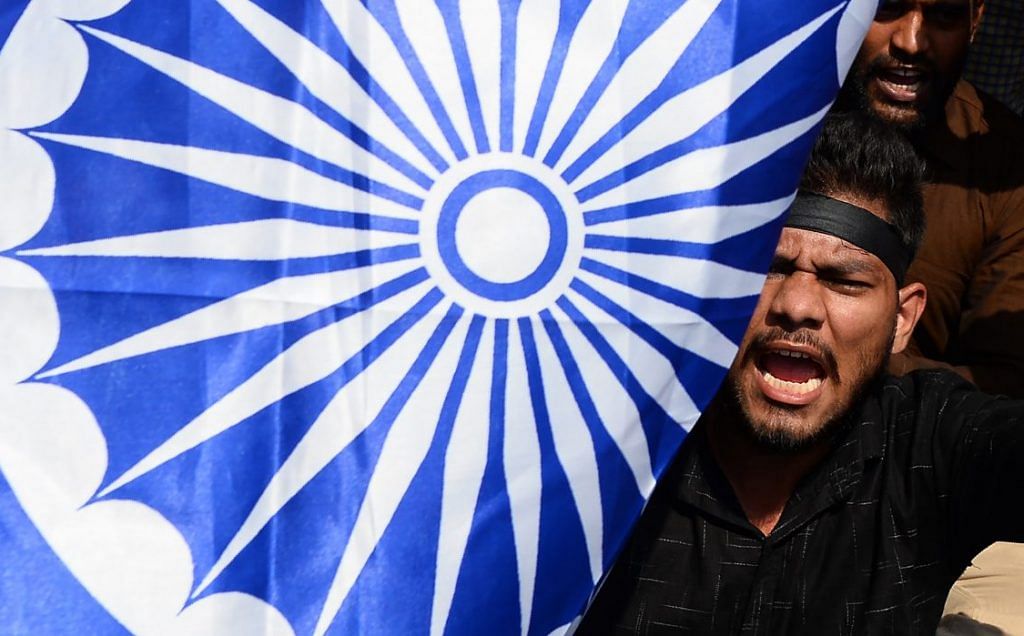In the shocking video, a Maharashtra policewoman is seen talking about beating up Dalits to vent her ire against them.
It was appalling to see a recent video from Maharashtra where a police officer is seen purportedly expressing her deep-seated distaste for the Dalit community and how she derives some sort of vengeful satisfaction from inflicting violence on Dalits. The video shows deputy superintendent Bhagyashree Navtake talking to some men, supposedly from the Maratha community, and telling them that she ‘thrashes’ Dalits who come to register cases under the Scheduled Castes and Scheduled Tribes (Prevention of Atrocities) Act. She went on to vent her ire about the reservation system in education and jobs. This kind of hate is a direct response to rise of the New Dalit in India.
The Dalit debate in India has raced ahead of the rhetoric on reservations and name-calling. The New Dalit is a firm believer of inherent dignity of every single individual. The New Dalit has empowered themselves from seven decades of reservation policies that Babasaheb Ambedkar put in place. She/he does not complain about their disenfranchisement or dispossession anymore, they aspire to frame and shape national debates. And this is what is giving birth to a backlash from the upper caste monopolies.
An inquiry has been launched against the police officer in Maharashtra after her shocking video went viral.
Also read: Caste slurs, witch-hunts & more come under SC/ST Atrocities Act. Is it ‘misused’?
The old structures of violence and repression were expected to erode with the wave of constitutionalism and rule of law after Independence. On the contrary, systemic and more institutionalised forms of discrimination and exclusion of minorities are coming to the fore every day.
The mostly upper caste executive and the elites in bureaucracy, government, media, civil society and politics have successfully and subtly maintained a hegemonic control over power and resources. Police personnel who were entrusted to enforce the law without bias are exposing their partisanship. The Maharashtra policewoman isn’t the first to have thrashed and discriminated against Dalits and minorities, and she won’t be the last.
It’s time for us as a community to go back and read Ambedkar. It is time to think beyond the conventional constitutional contours of Dalit empowerment. Information is power and knowledge is an enabler today. These are tools the New Dalit have and must deploy strategically in the new era. Ambedkar realised its significance early on.
Addressing students on 1 September 1951, Ambedkar had said, “It is a misconception that emancipation of lower class is an economic problem. That is a big mistake…The real issue is to make them aware of the importance of their existence for the progress of the nation; to make them aware about the reason of their backwardness which has made them subservient to the higher castes; to make them aware about the reason of their inferiority complex. These problems cannot be solved without proper higher education.”
Also read: The word Dalit is not ‘unconstitutional’. It is empowering
A policewoman in 2018 can afford to spew venom about Dalits because she knows her position won’t be contested – which is why education becomes an important tool for Dalits to reach the corridors of power.
There is a dismally low representation of Dalits in higher education today. We can probably count the number of Dalit vice-chancellors in the history of independent India on our fingers.
Ambedkar, at a public speech organised by Scheduled Caste Federation in 1945, said, “We should give the same importance to the spread of education as we give to our political movement. Because unless we get educated we cannot capture the key positions of power; and unless the key positions are not in our hands we cannot say that the real political power is achieved by us”.
Reservations in education and employment might have benefited a microscopic minority of Dalits, but has it served appropriately in the quest for a life of respect or not is a matter of debate. India has not seen a Dalit judge in Supreme Court after the retirement of Justice K.G. Balakrishnan in 2010. Not a single Dalit chief justice is serving today in any of the high courts. We haven’t had a Dalit cabinet secretary or a foreign secretary to date. More than seven decades of Independence and such a sorry state of affairs in India.
Also read: There is dangerous selectivity in how we look at violence against Dalits in India
There is an ongoing struggle for respect and for a voice in public debate today among Dalits. The rise of Jignesh Mevani in Gujarat and Chandrashekhar Azad Ravan in western Uttar Pradesh is a telling sign of the New Dalit. This new churning within the community is a call for more effective representatives in important decision-making positions. The next generation of social justice, anti-caste reforms will be ushered by the New Dalits who want to go beyond the ritualistic filling of reserved posts. They are demanding a more constructive intervention in policy making and national affairs. Police officers like Bhagyashree Navtake are threatened by what is ahead and responding with violence.
The author is a Fellow at India Foundation and an Assistant Professor of Law at Patna University.
